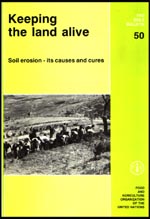 Keeping the land
alive
Keeping the land
alive
FAO Soils bulletin 50
Soil erosion - its causes and cures
by
Hubert W. Kelley
Consultant
sponsored by
German Agency for Technical Cooperation (GTZ)
Soil Resources, Management and Conservation Service
FAO Land and Water Development Division
Food and Agriculture Organization of the United
Nations
Rome, 1990
Reprinted 1990
The designations employed and the presentation of material in this publication do not imply the expression of any opinion whatsoever on the pan of the Food and Agriculture Organization of the United Nations concerning the legal status of any county, territory, city or area or of its authorities, or concerning the delimitation of its frontiers or boundaries.
M-57
ISBN 920101342-X
All rights reserved. No part of this publication may be reproduced, stored in a retrieval system, or transmitted in any form or by any means, electronic, mechanical, photocopying or otherwise, without the prior permission of the copyright owner. Applications for such permission, with a statement of the purpose and extent of the reproduction, should be addressed to the Director, Publications Division, Food and Agriculture Organization of the United Nations, Via delle Terme di Caracalla, 00100 Rome, Italy.
© FAO 1983
Preface
1. How soil is destroyed
Soil is a complex mixture
Soil teems with life
Only a fraction of land is arable
Erosion destroyed civilizations
The worst threat is erosion
Bad farming encourages soil loss
Rainfall energy varies
Why some soils erode easily
Organic soils soak up water
"Invisible" erosion takes toll
Gullies climb uphill
How erosion reduces yields
Eroding soil affects water resources
Windblown soil endangers land
Poor management degrades soil
Soils degrade through waterlogging and loss of nutrients
Some countries poison soils
2. Food production versus land degradation
Population pressures increase
Extent of soil erosion
Lower productivity forecast
Hillside forests destroyed
Overgrazing is critical
Salinization threatens production
Extent of sediment damage
Efficient shifting cultivation declines
3. Human barriers to conservation
Local institutions play role
Farmers need more income
Feeling for land essential
Land tenure affects erosion
Fertilizer purchases constrained
Political consciousness lacking
Laws may be unenforced
Funds spent unwisely
Machinery may hasten erosion
Social changes
Inappropriate technology can lead to failure
Local people must participate
4. Aims and techniques of soil management
Countries share experience
Covering the land helps
Zero tillage gains ground
Keep tillage to the minimum
Farmers practice contouring
Rotation reduces erosion
Terracing requires labour
Controlling windblown soil
Overgrazing challenges conservationists
Stern reclamation measures needed
Forests aid conservation
Watershed approach required
5. Government's responsibility for conservation
Responsibility for conservation rests with governments
Base policy on resource assessment
Single agency preferred
Drafting nationwide laws difficult
Punitive laws are ineffective
Improvement "packages" must attract farmers
Conservation teams include many disciplines
Local officials ensure success
Landusers form associations
Incentives are necessary
Direct payments have drawbacks
Attitude to short-term conservation costs
6. Obtaining more facts about resources
Start with soil surveys
Soil Map of the World and other aids to assessment
Making land capability assessments
Further research needed
German researchers study erosion
Forest crops and other possibilities
7. Sources of project assistance
Planning calls for compromise
Agro-forestry has potential
Certain practices unacceptable to farmersSweden assists Kenya government
8. Conclusion: A time for national action
Bibliography
Appendix:
World soil charter